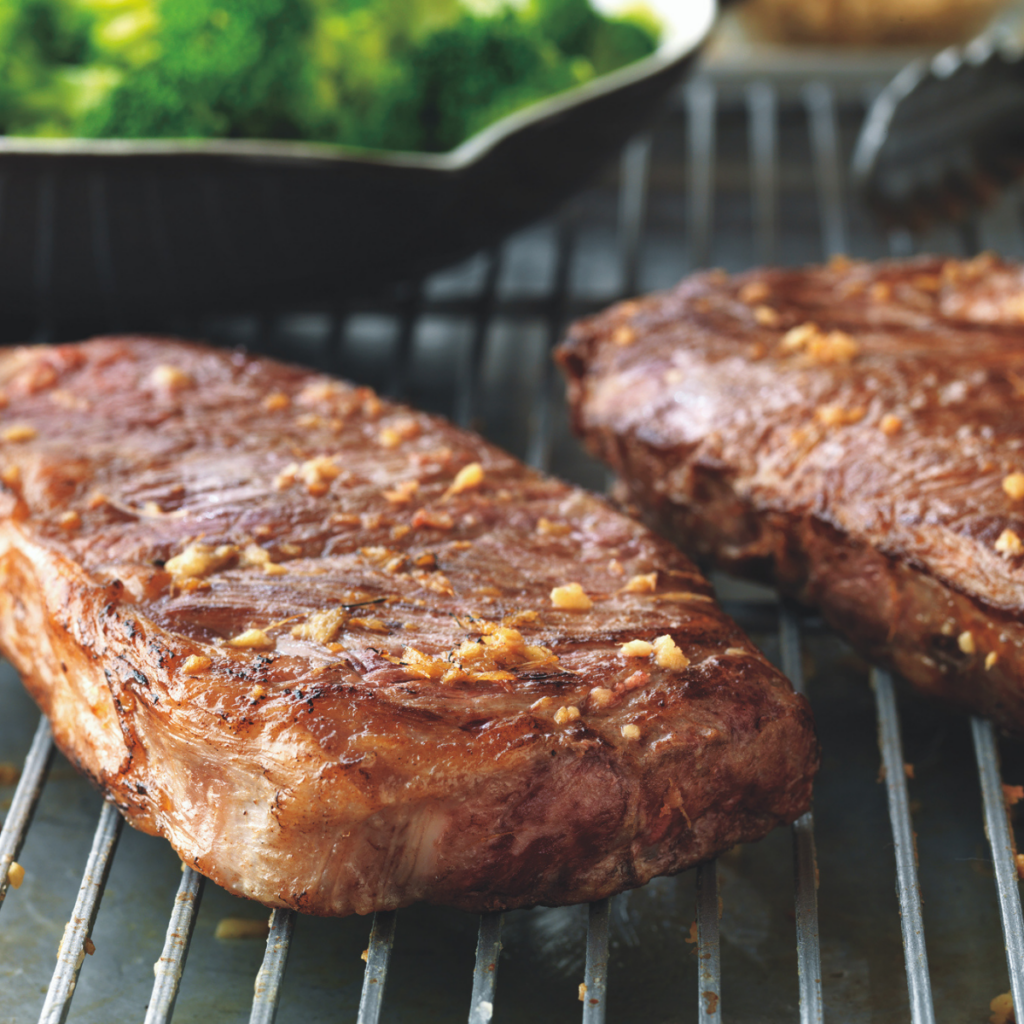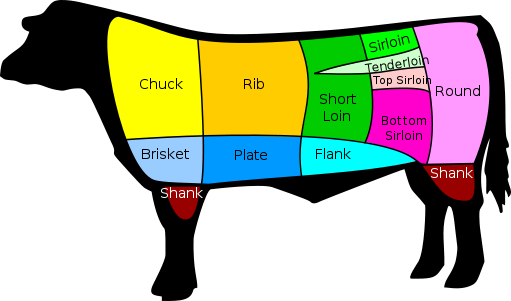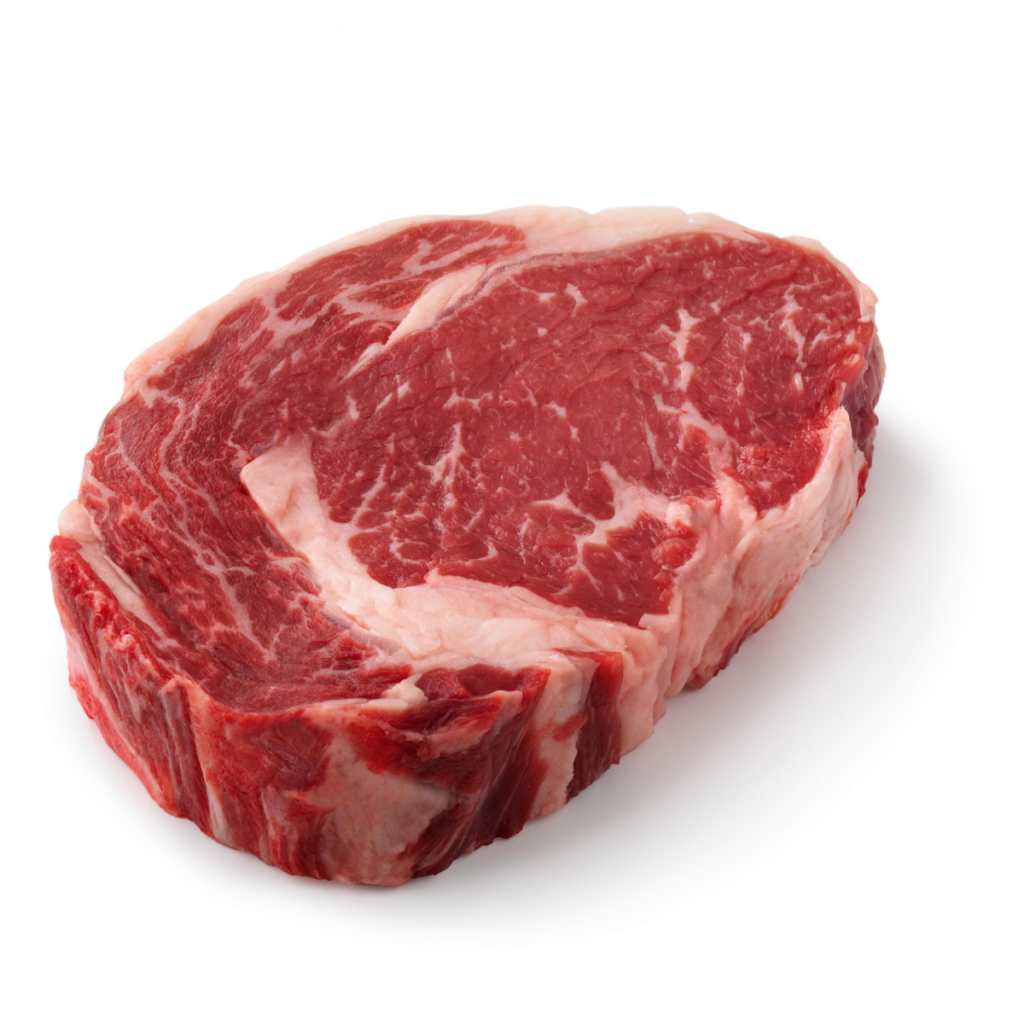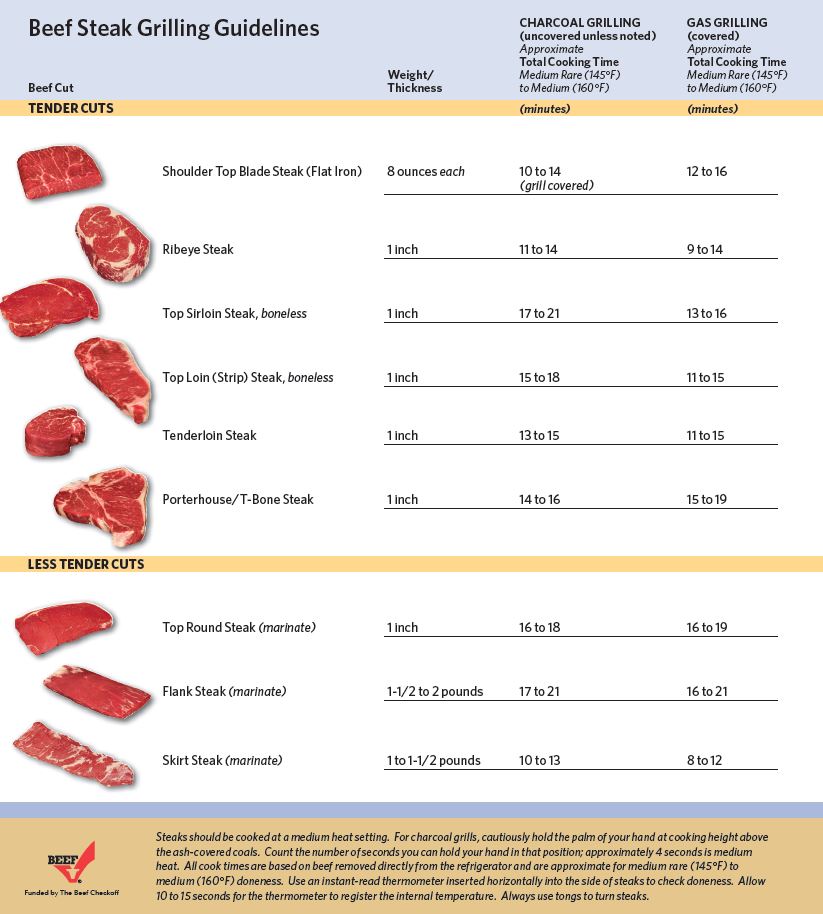Planning on grilling some steak? Then you’ll want to check out our list of the top 5 steak cuts for grilling.

Grilling in the summer is one of our favorite ways to make dinner. Sometimes we’re grilling for a party with friends, and other times it’s just us. No matter how many people you’re feeding, you can’t go wrong with these grill-favorite steak cuts.
The 5 Best Steak Cuts for Grilling
Strip, Sirloin, Ribeye, T-Bone and Filet are the 5 best steak cuts for the grill. Period.
There are lots of other great cuts of meat you can put on the grill — like skirt steak, flat iron steak, and flank steak — but we’ve listed the top five because of their taste and texture qualities.
Each of these steaks has different qualities based upon where it is on the steer. However, it’s important to note that all of these cuts are from the center of the steer in the loin and rib section. That’s important because, as we’ve talked about before, meat is a muscle, the tenderness of a steak is related to how much work the muscle does. A good rule of thumb to remember is that beef gets more tender as the distance from horn and hoof increases. Since a cow is constantly using its legs and neck, those muscles are more developed and a steak from those areas will be less tender.

It’s also important to note that some of these cuts can be found bone-in or boneless. Some research has shown that bone-in steaks have slightly more flavor and moisture than boneless steaks, but the difference is minimal. Our preference is boneless because having a bone can make cooking more difficult since the meat next to the bone cooks more slowly. That means depending on how long you cook, the meat closer to the bone can be slightly more or less cooked.
Jump to:
Strip steak
A strip steak goes by many different names: New York Strip, Kansas City Strip or Top Sirloin, just to name a few. This is a tender steak that comes from the area just behind the ribs. It has a beefy flavor, but not as strong as a ribeye. A strip steak can either be bone-in or boneless. They’re usually between 8-14 ounces.
Sirloin steak
Sirloin steaks are naturally lean. They’re usually between 5-10 ounces. They are a great larger steak when you’re on somewhat of a budget.
Ribeye (or Rib) steak
A ribeye steak is the most flavorful, well-marbled cut of beef. It comes from the center of the cow in the rib section. A ribeye steak is a boneless steak, and a rib steak is bone-in (it’s also known as a bone-in ribeye). It’s usually between 8-14 ounces.

T-Bone steak
The “T” shaped bone in the center of a T-bone steak joins two types of steak: filet and strip. When grilling, be sure the tenderloin (the less marbled side) is further away from the direct heat and the strip side is closer to the heat. A T-bone is a large steak and usually about 18 ounces. Another steak that’s similar to the T-Bone is the Porterhouse.
Filet Mignon steak
Beef tenderloin is the most tender muscle on an animal and has very little fat. The leanness of the cut is why it’s sometimes wrapped in bacon. Filet Mignon should be cooked with quick, high heat (like grilling or pan-searing). Typically, a filet is 6-8 ounces.
Best Seasoning for Steak
A good cut of beef doesn’t need fancy seasonings that cover up the taste of the beef, but it does need salt. When salt is added to beef, it breaks down the beef’s muscle protein, draws moisture to the surface of the meat, and has a hydrating effect. It ultimately creates a juicier steak.
When salting steak, use ¾ teaspoon to 1 teaspoon per pound of beef. Salt about 1-hour before cooking, and be sure to apply the salt evenly to the front, back and side of the beef. If you struggle with applying it evenly, season from about two feet above the steak, and make it “rain” salt. This will avoid having a concentration of salt in one area and allows for even coverage. Thicker cuts of steak will typically need more salt than thinner cuts.
Kosher Salt is our go-to salt when salting steak or roasts. We like it because it has large, coarse grains and the large granules cling to the beef when seasoning. The large grains also make it easier to pinch and sprinkle. Different brands of kosher salt have different crystal sizes. We like this one the best.
How Long to Cook Steak on Grill?
So, how long do you grill steak? The answer depends on the thickness of the steak and desired doneness. If you’re cooking a thinner steak, the cook time will be less than a thicker steak. If you like a medium-well steak, the cook time will be more than a medium-rare steak. We talked indepth about how long to grill steak, so this is a quick overview.
Although you can try and grill steak by time (see chart), there’s only one way to get it right every time — you have to use an instant read thermometer.
STEAK DONENESS TEMPERATURE GUIDE
- Rare: 120-129°F A rare steak is usually very red in the center and can still be cool to the touch. It’s just past raw in the center. For a 1 ½ inch steak, it will be approximately 6-8 minutes grilling time
- Medium-Rare: 130-134°F A medium rare steak has a warm red center. It’s many people’s preferred doneness. For a 1 ½ inch steak, it will be approximately 7-10 minutes grilling time
- Medium: 135-144°F A medium-cooked steak is very warm and usually pink, not red. The steak will have a slightly drier and chewier. For a 1 ½ inch steak, it will be approximately 10-12 minutes grilling time
- Medium-Well: 145-154 °F A medium well steak is usually just slightly pink in the center and has lost much of its juices.
- Well Done: 155°F+ A well done steak has no pink. It’s much tougher since all the juices have been cooked out of the beef. For a 1 ½ inch steak, it will be approximately 12-15 minutes grilling time
An instant read thermometer is the only way to tell a steak’s doneness, not the color or the “feel” of the steak. If you don’t own an instant read thermometer, please get one right now! You will quickly make back any money you spent by never overcooking another piece of expensive meat again. Here’s our favorite.
Once you have an instant read thermometer, be sure you’re using it correctly. Insert the thermometer most of the way through the steak, and draw it out slowly. As you do, you’ll see the temperature change as you move the probe through the steak’s temperature gradients. The lowest number you see is the best indication of the internal doneness of that steak. Be sure to pull the steak off the grill about 5°F BEFORE it reaches the desired temperature. This allows for carryover cooking.

Other Great Beef Cuts to Grill
Hamburger
When we’re grilling for lots of people, one of the cuts of beef we use the most often is ground beef (I’m sure you’re not surprised). Ground beef is an awesome way to feed an army of people, especially since it’s relatively inexpensive.
- Seasoning: Salt and pepper is a classic favorite when seasoning just about any meat, and that is true for hamburgers too. If you want to be more adventurous with a sweet and spicy hamburger rub, here’s a good rub to try.
- How to cook: We recommend grilling your favorite burger over high heat for about 4 minutes, flip and grill another 4 minutes, and then let the hamburger rest for about two minutes before eating it. And whatever you do, don’t use a spatula to press the burger down or flatten it as its cooking. When you do this, you lose some of the juiciness that makes a great burger.
- Tip: Once you’ve created your patty, make a shallow indent that’s about 1 inch wide in the middle of the patty with your thumb. This will help the beef keep its shape when it cooks since beef contracts and shrinks when it cooks.
Ribs
Some people are intimidated by ribs, but don’t be one of them! They’re one of the best cuts of beef to grill. Plus, they’re very extremely forgiving because of the marbling (fat) on them. There are two basic types of ribs — short ribs and back ribs. Short ribs are from the lower part of the rib cage, and it’s what we usually grill.
- Seasoning: If you’re making ribs for the first time, we recommend a basic salt and pepper seasoning so that you’re sure to taste the full flavor of the meat. After that, try experimenting with rubs and marinades.
- How to cook: Ribs get more tender the longer they’re cooked, but you want to be careful not to overcook them either. To prevent overcooking, make sure you start with a fully preheated grill. You want it to be a hot grill (but not a blazing fire). The size of the ribs will vary your cooking time so don’t rely fully on a ribs recipe. You can often times use a meat thermometer to test the doneness, but that can sometimes be tough since there is limited meat on each rib. One trick to telling if they’re done is to pull apart two side-by-side ribs. If the meat tears apart easily, they’re done.
- Tip: Don’t boil the ribs! There are many recipes that recommend boiling and they say it makes them more tender, but we think that will cause you to loose some flavor.
One More Thing!
Do you want to learn more about beef? Join our weekly e-newsletter where we share farm happenings, recipes and beef availability. Sign-up and get a cheat sheet with 9-must-ask questions before buying beef directly from a farmer. Or, we have an entire ebook about beef that goes through purchasing and preparing beef from a cattle farmers perspective.
Here are a few other links you may like:
- What everybody ought to know about beef cuts
- Buying a Cow. How Much Beef Is It?
- 7 Steps to Grilling a Steak to Perfection
- How We Raise Our Grass Fed Beef
- Easy Beef Brisket Recipe (oven-roasted)
- The Best Farm Books for Kids
Disclosure: This post contains affiliate links. This means if you click on the link and purchase the item, we will receive an affiliate commission at no extra cost to you. All opinions are our own and we only recommend products that we truly believe in.
We participate in the Amazon Services LLC Associates Program, an affiliate advertising program designed to provide a means for us to earn fees by linking to Amazon.com and affiliated sites. See our disclosure policy for more details.


Great refresher. Always nice to be reminded about the basics. This will be a great resource for those just getting into grilling. Thanks!